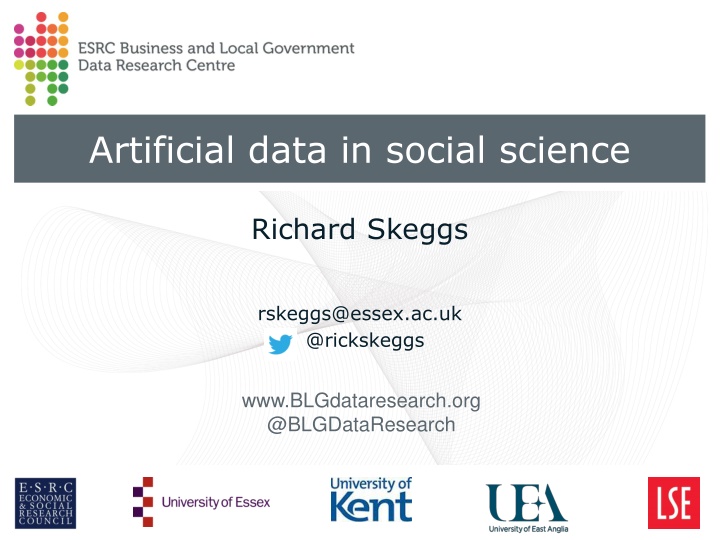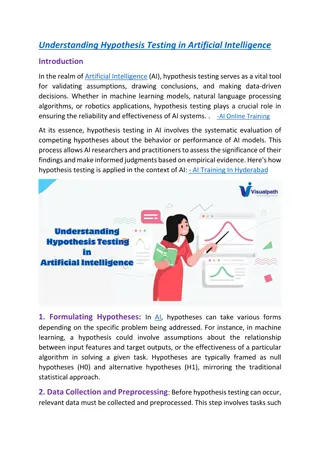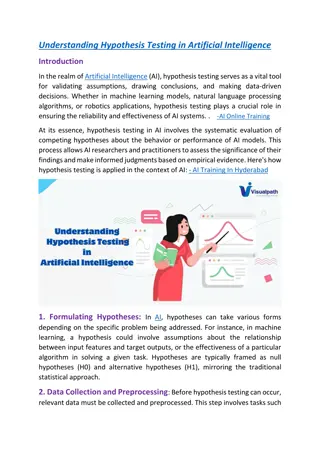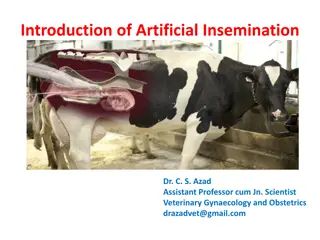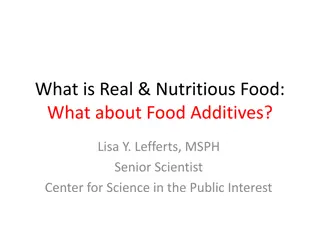Artificial data in social science
Artificial data in social science, first proposed in 1993, refers to synthetic data that mimics real data to reduce privacy concerns, enhance small datasets, and aid in model development and training. Tools like Python, Synthetic Data Vault, and SynthPop are used for creating artificial data, with techniques such as logistic modeling and CART employed in Python and R for data synthesis. The Synthetic Data Vault study shows comparable results between synthetic and control data, highlighting the effectiveness of artificial data in data science research.
Download Presentation

Please find below an Image/Link to download the presentation.
The content on the website is provided AS IS for your information and personal use only. It may not be sold, licensed, or shared on other websites without obtaining consent from the author.If you encounter any issues during the download, it is possible that the publisher has removed the file from their server.
You are allowed to download the files provided on this website for personal or commercial use, subject to the condition that they are used lawfully. All files are the property of their respective owners.
The content on the website is provided AS IS for your information and personal use only. It may not be sold, licensed, or shared on other websites without obtaining consent from the author.
E N D
Presentation Transcript
Artificial data in social science Richard Skeggs rskeggs@essex.ac.uk @rickskeggs www.BLGdataresearch.org @BLGDataResearch www.BLGdataresearch.org @BLGDataResearch
What is Artificial Data First proposed in 1993. Often referred to as Synthetic data. In effect made up data. Mimics real data. www.BLGdataresearch.org @BLGDataResearch
Why Use Artificial Data Reduces privacy concerns. Bolsters small datasets for models. Used for developing and training a model. Can be cheaper to obtain. www.BLGdataresearch.org @BLGDataResearch
Creating Artificial Data Python synthetic data tools. Synthetic Data Vault Python & Numpy R synthetic data tools. Synthpop www.BLGdataresearch.org @BLGDataResearch
Synthetic Data Vault Patki, N., R. Wedge, and K. Veeramachaneni. The Synthetic Data Vault. In 2016 IEEE International Conference on Data Science and Advanced Analytics (DSAA), 399 410, 2016. https://doi.org/10.1109/DSAA.2016.49. www.BLGdataresearch.org @BLGDataResearch
Synthetic Data Vault 34 data scientist given datasets. No statistically different result between synthetic & control data. www.BLGdataresearch.org @BLGDataResearch
Synthetic Data in Python Trumania: Creates test data based on a scenario. Synthetic-data-generator: generate random data follows uniform distribution. www.BLGdataresearch.org @BLGDataResearch
Synthetic Data in R SynthPop R package. Uses a logistic model predict variables based on real data. Recursive model building up variables. www.BLGdataresearch.org @BLGDataResearch
SynthPop Variables synthesised using CART. classification and regression trees. The model is created by binary recursive partitioning. Missing values are modelled. A model is applied to each column. www.BLGdataresearch.org @BLGDataResearch
SynthPop Syn(data, Visit.sequence, k) Usage: Data a dataframe or matrix containing original data. Visit.sequence - column indices specifying the order of synthesis K size of synthetic data (optional) Method meyhod used for synthesising by default CART (optional) Example: syn.data<-syn(orig.data[c(7:28),], visit.sequence=c(7:28), k=39) www.BLGdataresearch.org @BLGDataResearch
SynthPop Administrative Data Research Centre Scotland | Chris Dibben| 20 June 2014 www.BLGdataresearch.org @BLGDataResearch
SynthPop synthpop: Bespoke Creation of Synthetic Data in R Beata Nowok, Gillian M. Raab, Chris Dibben Published 2015 www.BLGdataresearch.org @BLGDataResearch
SynthPop if(!require(synthpop)) { install.packages("synthpop") } library(synthpop) syn.data<-syn(iris[c(1:150),], visit.sequence=c(1:150), k=150, proper=TRUE) for(x in 1:nrow(iris)) { if(x==1) { synth.data<-as.data.frame(syn.data$syn[x, ]) } else { synth.data[x,]<-syn.data$syn[x,] } } View(synth.data) plot(synth.data$Petal.Length, synth.data$Petal.Width) www.BLGdataresearch.org @BLGDataResearch
SynthPop Original Data Synthetic Data www.BLGdataresearch.org @BLGDataResearch
SynthPop www.BLGdataresearch.org @BLGDataResearch
SynthPop syn.data<-syn(iris, visit.sequence=c(1:150), k=150, proper=TRUE) www.BLGdataresearch.org @BLGDataResearch
SynthPop www.BLGdataresearch.org @BLGDataResearch
SynthPop syn.data<-syn(iris, method="parametric", visit.sequence=c(1:150), k=150, proper=TRUE, default.method = c("normrank", "logreg", "polyreg", "polr")) www.BLGdataresearch.org @BLGDataResearch
SynthPop www.BLGdataresearch.org @BLGDataResearch
SynthPop syn.data<-syn(iris, method="parametric", visit.sequence=c(1:150), k=150, proper=TRUE, default.method = c("normrank", "logreg", "polyreg", "polr"), seed=6000) www.BLGdataresearch.org @BLGDataResearch
SynthPop www.BLGdataresearch.org @BLGDataResearch
Any Questions? Richard Skeggs rskeggs@essex.ac.uk 5 April 2018 www.BLGdataresearch.org @BLGDataResearch www.BLGdataresearch.org @BLGDataResearch
